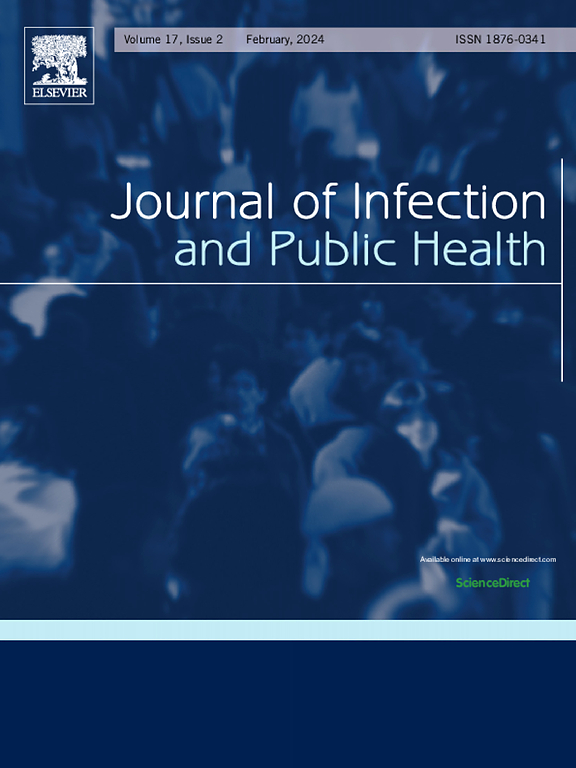2020 - 2023年日本2019冠状病毒病时空格局变化
IF 4.7
3区 医学
Q1 INFECTIOUS DISEASES
引用次数: 0
摘要
2019冠状病毒病(COVID-19)在各国的传播情况各不相同。COVID-19在日本的时空趋势仍未得到充分研究。因此,本研究旨在对日本各县感染/死亡的时空演变进行详细调查,分析2019冠状病毒病在大都市和非大都市地区的传播变化模式。方法从2020年1月15日至2023年5月9日具有全国代表性的开源数据中提取数据,计算感染发生率和死亡率。此外,这些比率是通过将地级市一级的比率除以全国一级的比率得到的,以便在全国范围内进行比较。然后,通过热图描述COVID-19的时空趋势。采用泊松回归模型比较非都会区和都会区感染和死亡的发病率比(IRRs)。结果在研究期间,日本经历了8波COVID-19,导致33,738,398例确诊感染和74,688例死亡。随着时间的推移,感染和死亡人数都显著增加。传播最初集中在大都市区。到2022年6月,非大都市县受到保护,感染和死亡人数较低。此后,COVID-19变得更加广泛,在非大都市区出现了更局部的激增。最终,在第八波(2022年10月16日至2023年5月9日)期间,非大都市县的IRR显著增加,感染的IRR达到1.25(95 %可信区间(CI), 1.15-1.34),死亡的IRR达到1.38(95 % CI, 1.16-1.65)。结论在日本,COVID-19的传播在大流行的前两年受到抑制,特别是在非大都市地区,但随着时间的推移,趋势发生了变化,从2022年底开始,非大都市地区的感染和死亡人数有所增加。这些发现强调了解决大都市和非大都市县之间可能存在的地理差异的重要性,延迟非大都市县的大规模激增可能是一个重要的结论,可以帮助未来管理重大传染病暴发。本文章由计算机程序翻译,如有差异,请以英文原文为准。
Changes in the spatiotemporal patterns of COVID-19 in Japan from 2020 through 2023
Background
The spread of coronavirus disease 2019 (COVID-19) varied among countries. The spatiotemporal trends of COVID-19 in Japan remain understudied. Therefore, this study aimed to conduct a detailed investigation of the spatiotemporal evolution of infections/deaths across prefectures in Japan, to analyze the changing patterns of COVID-19 circulation in metropolitan and nonmetropolitan areas.
Methods
We extracted data from nationally represented open-source data from January 15, 2020, to May 9, 2023, and we calculated the incidence rate of infection and the mortality. Further the ratios were obtained by dividing those rates in prefectural level by those in national level to make them comparable across country. Then, the spatiotemporal trends of COVID-19 were depicted via heatmaps. A Poisson regression model was used to compare the incidence rate ratios (IRRs) of infection and death between nonmetropolitan and metropolitan prefectures.
Results
During the study period, Japan experienced eight waves of COVID-19 resulting in 33,738,398 confirmed infections and 74,688 deaths. Both infections and deaths increased significantly overtime. Transmission was initially concentrated in metropolitan prefectures. Nonmetropolitan prefectures were protected and had lower numbers of infections and deaths through June 2022. Thereafter, COVID-19 became more widespread, with more localized surges in nonmetropolitan prefectures. Eventually, during the eighth wave (October 16, 2022-May 9, 2023), there was a marked increase in the IRR in nonmetropolitan prefectures reaching 1.25 (95 % confidence interval (CI), 1.15–1.34) for infection and 1.38 (95 % CI, 1.16–1.65) for death.
Conclusions
In Japan, COVID-19 transmission was suppressed for the first 2 years of the pandemic, especially in nonmetropolitan prefectures, but the trends changed over time, and more infections and deaths were observed from late 2022 in nonmetropolitan prefectures. These findings underscore the importance of addressing the geographical disparities that likely exist between metropolitan and nonmetropolitan prefectures Delaying large surges in nonmetropolitan prefectures may be an important takeaway that could aid in the future management of major infectious disease outbreaks.
求助全文
通过发布文献求助,成功后即可免费获取论文全文。
去求助
来源期刊

Journal of Infection and Public Health
PUBLIC, ENVIRONMENTAL & OCCUPATIONAL HEALTH -INFECTIOUS DISEASES
CiteScore
13.10
自引率
1.50%
发文量
203
审稿时长
96 days
期刊介绍:
The Journal of Infection and Public Health, first official journal of the Saudi Arabian Ministry of National Guard Health Affairs, King Saud Bin Abdulaziz University for Health Sciences and the Saudi Association for Public Health, aims to be the foremost scientific, peer-reviewed journal encompassing infection prevention and control, microbiology, infectious diseases, public health and the application of healthcare epidemiology to the evaluation of health outcomes. The point of view of the journal is that infection and public health are closely intertwined and that advances in one area will have positive consequences on the other.
The journal will be useful to all health professionals who are partners in the management of patients with communicable diseases, keeping them up to date. The journal is proud to have an international and diverse editorial board that will assist and facilitate the publication of articles that reflect a global view on infection control and public health, as well as emphasizing our focus on supporting the needs of public health practitioners.
It is our aim to improve healthcare by reducing risk of infection and related adverse outcomes by critical review, selection, and dissemination of new and relevant information in the field of infection control, public health and infectious diseases in all healthcare settings and the community.
 求助内容:
求助内容: 应助结果提醒方式:
应助结果提醒方式:


